By Jean Huon
The well-known cartridge factory of the Gévelot Company had in Saint-Germain Laval, close to Saint-Etienne, a subsidiary company that manufactured .22 Long Rifle carbines. These weapons were crude and worked with a blowback bolt, with a typical vertical bar that replaced the firing pin. It had no extractor. The production of these guns was made by the Gévarmoise Company.
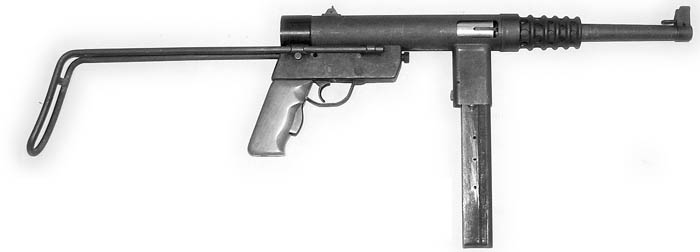
In 1956, the Gévarm Company developed a submachine gun in two versions: a model with a wooden stock and another with a retractable wire metal stock. Respectively designed D.3 and D.4, these weapons experienced a limited development in spite of the efforts carried out by the company to make them better known.
Description
The D.3 had a fixed wooden stock manufactured with two elements similar to that of the Japanese Arisaka rifle and a rubber pad replaced the butt plate.
The model D.4 is provided with a retractable steel stock. Its two stems slide inside guides and the stock is locked by means of a transverse pushbutton. The stock enables three positions: fully extended, an intermediate position, and fully retracted.
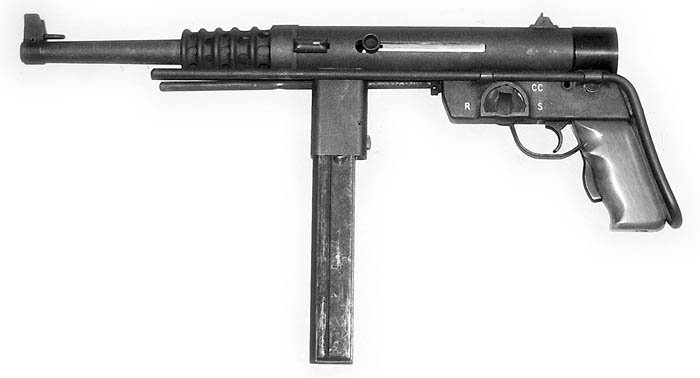
The receiver is tubular in shape and is threaded at the rear to receive an end cap made of light alloy. The end cap supports the recoil spring guide rod. The end cap has two pins in its lower part to ensure proper positioning and locks it in place to prevent the end cap from unscrewing from vibration.
The ejection port is located on the right side of the receiver and the cocking handle is on the left. In front of the cocking handle on the left side of the receiver is the ejector, which is also the barrel collar lock. The bolt is similar to that as used in the Sten submachine gun and is chrome plated steel with a truncated head that supports the fixed firing pin and the extractor. The recoil spring is 18mm in diameter, made of 1.8mm wire, and is composed of 39 whorls. The recoil spring is guided only on 9cm, which is the length of the recoil spring guide rod attached to the rear end cap.
The trigger pack is made of cast iron with some machining passes. The trigger pack contains the trigger, sear, selector as well as the wire stock guides and the stock locking bar. The trigger pack attaches to the receiver tube with a back hook where it comes to rest across a pin. A screw with knurled head is located at the front that locks it in place. The fire control selector switch is on the left side of the trigger pack with three positions denoted: S to the rear for safety, CC in the middle for single shot, and R to the front for full automatic fire. The grip, which was originally furnished with plates fixed by means of a transverse screw, was later made in solid wood and was fixed with a vertical screw. A grip safety is located on the front face.
The magazine housing is a rectangular tube brazed under the receiver. The magazine is specific to the Gévarm and is made out of thick sheet metal and is retained in the magazine well by a magazine lever catch.
The 220mm (8.66 inches) barrel is in 9mm calibre with six right groves, one turn in 270mm (10.63 inches). It is retained on the receiver by a short perforated collar made of lathe turned steel that is screwed to the front of the receiver. The ejector is also used as a stop for the collar. The front sight is a vertical post protected by two ears to each side. The rear sight consists of two open V slots for 50 or 100 meters. All the metal parts of the weapon are parkerized. A carrying sling can be affixed on a ring under the front sight and on a bar welded at the rear of the stock.
Disassembly-Reassembly
Remove the magazine and clear the gun. Press the retaining button and remove the stock. Press on the collar retaining pin and unscrew the collar. Remove the barrel and collar forward. Take off the ejector. Take off the cocking lever. Extract the bolt and recoil spring. Unscrew the knurled screw located at the front of the trigger housing and separate from the receiver. Press the retaining pin and unscrew the end cap. Reassembly is carried out in the reverse order.
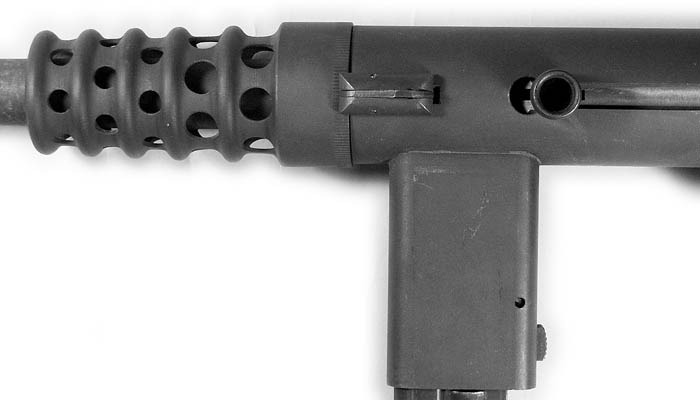
Tests
Gévarm submachine guns were presented on February 19th, 1957, by Messieurs Lesage and Brûlebois from the Gévarm Company, to the Versailles-Satory Proving Ground. The technical commission consisted of Engineer Lafon from the D.E.F.A., Colonel Legall, Major Duhamel and Captain Coudret from the Technical Section of Artillery.
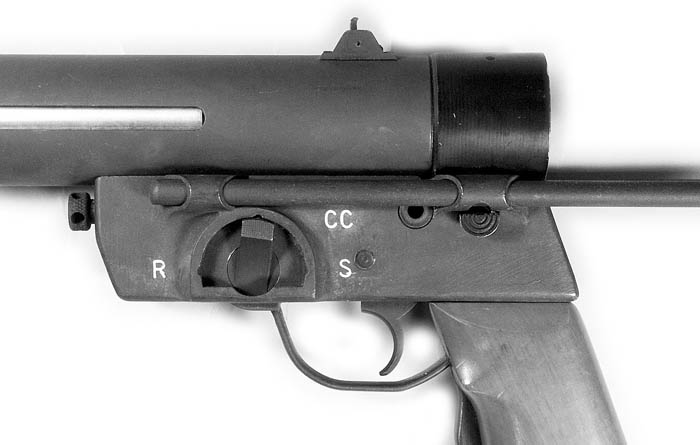
Two guns were presented: one model D.3 and one model D.4, bearing serial numbers 353020 and 353043 respectively. It was initially noted that there was a defect of the safety device in the event that the weapon should fall. Though there were no inopportune shots resulting from these incidents, it was necessary to loosen the screw of the trigger mechanism to free the bolt. Shooting tests were made with five or six magazines for each gun, with two feeding incidents. Cyclic rate was 670 rpm.
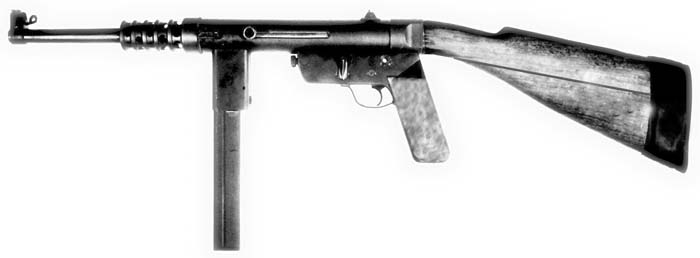
Each gun was later shot with 350 cartridges (single shot) and 650 cartridges (burst). It was noted then: • SMG No. 353043: when shooting single shots there were five failures to fire and two feeding incidents; when shooting burst fire there were seven feeding incidents.
• SMG No. 353020: when shooting single shots there were two feeding incidents; when shooting burst fire there were seven feeding incidents.
Precision tests were made at 50 and 100 meters with cartridges made by Tarbes Cartridges Factory in 1955. At 50 meters, dispersion was 16 to 18 cm (6.30 to 7.09 ins.) with one of the two weapons and 16 to 22 cm (6.30 to 8.66 ins.) for the other. At 100 meters, this result was 34/39 cm (13.39/15.35 ins.) and 38/40 cm (14.96/15.75 ins.).
The conclusion was that the weapon was pleasant to shoot at the shoulder or the hip. The selector does not guarantee 100% of shooting single shots. During tests, 1% of incidents were due to feeding problems. The accuracy of the weapon is fine but the sights are not good. In the safety position, in the event of a fall of the weapon on the stock, the bolt can be blocked by the sear.
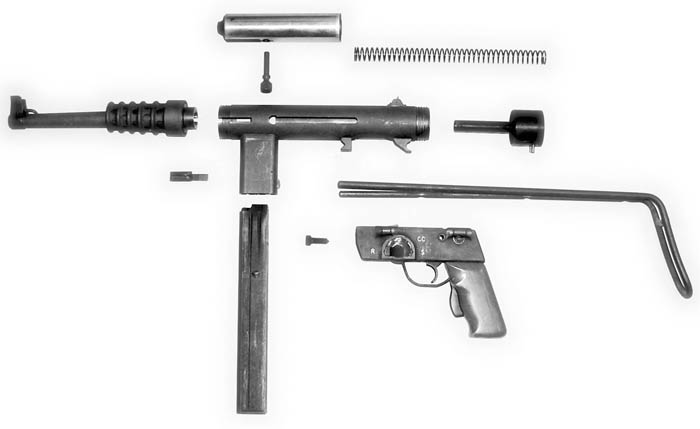
It would undoubtedly be easy to correct the disadvantages noted during the tests, but in spite of its qualities, this submachine gun arrived too late at a time when the French Army was largely provided with the MAT 49 SMG.
It is estimated that 3,000 to 4,000 guns were produced. Some of them were sold to French government organizations such as Customs, the Highway Police (the motorcyclists who were equipped with it transported the weapon in one of the saddlebags of the motor bike) and Police in the Parisians suburbs until 1985. Some others were sold until the end of the 1970s in of the Middle East. The few tens remaining in stock at Gévelot Company were sold about 1990 to gunsmiths in France and, after de-activating, they are now held by some lucky collectors.
| Specifications | ||
| Gévarm D.3 | Gévarm D.4 | |
| Caliber: Ammunition: Overall length: Length /stock retracted: Barrel length: Method of operation: Weight/ no magazine: Magazine capacity: Cyclic rate: | 9mm 9mm Luger 0.800 m (31.5 in.) — 0.220 m (8.66 in.) Blowback 3.650 kg (8.05 lbs.) 32 shots 600 rpm | 9mm 9mm Luger 0.800 m (31.5 in.) 0.500 m (19.69 in.) 0.220 m (8.66 in.) Blowback 3.200 kg (7.05 lbs.) 32 shots 600 rpm |
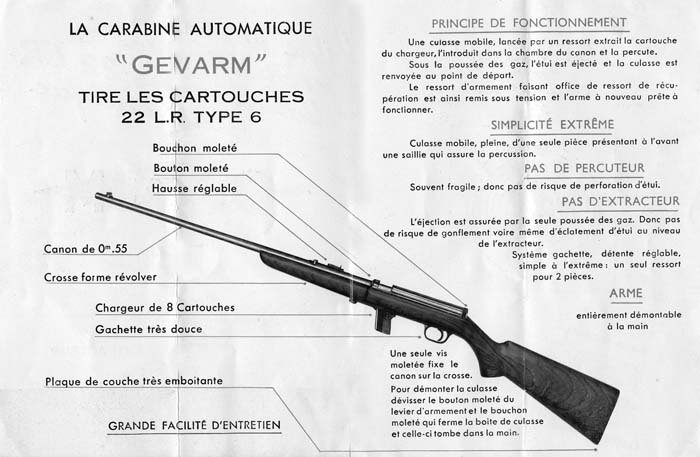
| This article first appeared in Small Arms Review V12N6 (March 2009) |











